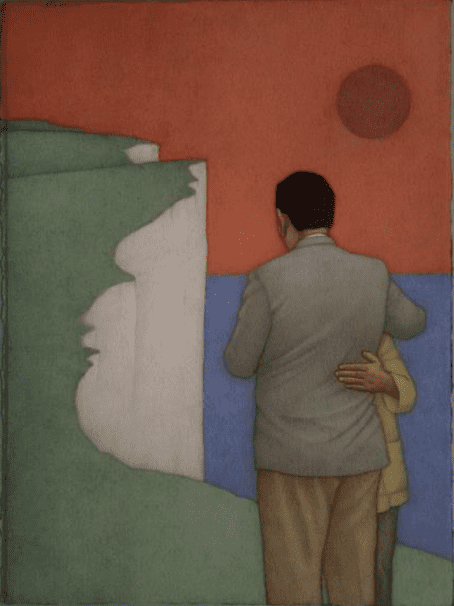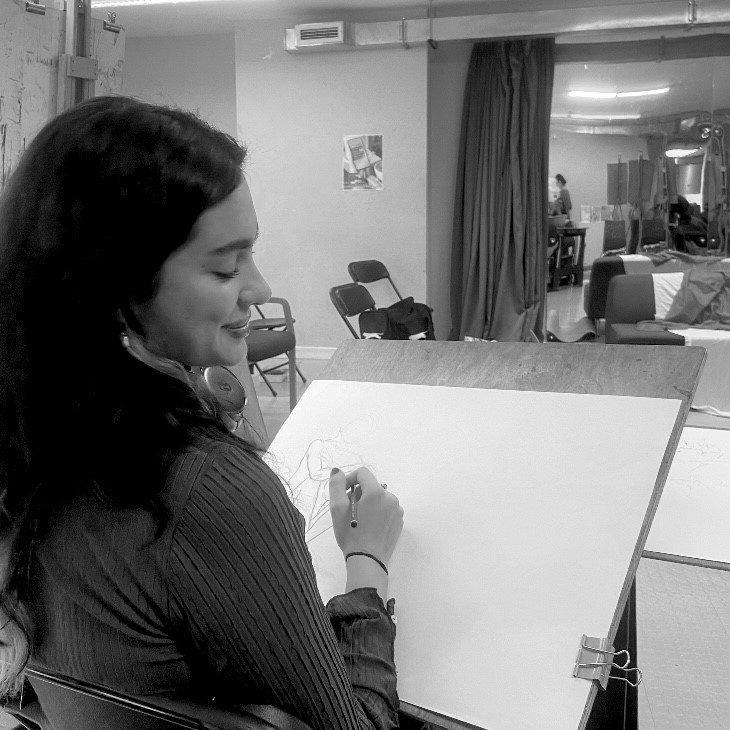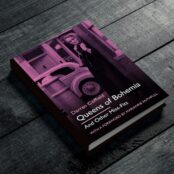Endurance (2024), a solo show featuring work by the acclaimed watercolourist, Shanti Panchal was held at Grosvenor Gallery from May 10 to June 2nd. Known for exhibiting some of the very best South Asian art, the Grosvenor Gallery show presented several smaller watercolours largely featuring poignant scenes of everyday migrant life centred around a large mural from which the exhibition took its name. ‘Endurance’ (2022) was commissioned by Transport for London as part of an ongoing series which invites artists to respond to Brixton’s rapid development, and was displayed for a year (November 2022 – November 2023) above the escalators of Brixton’s underground station.
This piece marks the second occasion that Panchal has been commissioned by a London government body to produce a mural which engages with the city’s migrant experience. The comparison between ‘Across the Barrier’ (1985) and ‘Endurance’ is particularly enlightening in terms of the development of race relations in the UK over the past 40 years.
Born in rural Gujarat, Shanti Panchal began his muralism young. As a child, he used the red carpenter’s paint — always in good supply due to his family’s trade — to paint birds, flowers and animals on neighbouring houses. Aged 14, Panchal ran away to Mumbai to study at the Sir Jeejebhoy School of Art where he studied figure and life painting and was acquainted with one of his main influences: the miniaturism of early Jain manuscripts. Continuing his studies in the UK and the US, Panchal discovered the abstract use of space and colour in Western works such as those of Rothko, El Greco and Bacon. In this sense, the influences found in Panchal’s work are themselves intertwined with and metaphorical of the artist’s identity as a migrant.

Panchal’s big break came in 1985 when the Labour-led Greater London Council commissioned him alongside seven other artists (Dushela Ahmad, Keith Piper, Chila Kumari Singh, Lubaina Himid, Simone Alexander, Gavin Janjes, and Tam Joseph) to participate in the Anti-Racism campaign by creating murals in areas of the city well-known for their migrant history; namely Brixton, Shadwell, Southall, and Notting Hill.
This commission, ‘Across the Barrier’ (1985), co-created with Dushela Ahmad, was significantly toned down from Panchal’s original design. In one section of this piece, the artist initially wanted to portray a violent racist attack carried out by skinheads which had happened some years earlier on the nearby Teviot Estate. Instead, Panchal opted to deliver a scene of white men in business suits pointing accusingly at a Bengali family as neighbours sign an ‘anti-Asian’ petition. The family are gathered around a television screen displaying Margaret Thatcher’s image and appear to have barricaded themselves inside their home. Although this scene is significantly less dramatic in comparison with Panchal’s original designs, its clear narrative triggers an immediate and unambiguous interpretation.
Panchal’s most recent mural and the centrepiece of Endurance (2024), on the other hand, presents much subtler political undertones. Its meaning is largely contextually imbued: by its name, and by its being commissioned by TfL to sit above the escalators in Brixton tube station. The buildings and structures positioned in the background — namely the Caribbean War Memorial, the Cherry Groce Memorial, the Tate Modern, the Brixton Windmill, and the Black Cultural Archives — also call to mind London’s immigration history yet, overall, this mural is far more politically abstract than its 1985 predecessor.
All in all, this piece feels much more personal to Panchal: the flatness of composition and shadowless figures with enlarged almond eyes point to the artist’s treasured early Jain miniatures. The signature darkening of the figures’ foreheads at the site of Shiva’s third eye references Panchal’s Hindu faith and spiritual vision. The rich earthy colour palette is reflective of tones found in both his native Gujarat and the works of two of his primary influences, Bacon and Rothko. Panchal’s deliverance of a more individualised piece suggests a change in London’s attitudes — perhaps a more evolved social understanding of the nuance of migrant experience.
The velvety depth of colour permeating these pieces reminds the viewer of Panchal’s technique of ‘injecting’ pigment into the paper through wash after wash of watercolour in an intimate labour of love. Endurance 2023 took the artist six months of layering, carving, and scraping to achieve and the result is a profound ternary relationship between the artist, the work, and the viewer; even inanimate objects portrayed in the supporting pieces are imbued with huge importance through the care and consideration of this technique.
In this piece, Panchal’s figures do not meet each other’s gaze but instead look past one another. Andrew Lambirth suggests that this is a result of the lack of privacy in Panchal’s Gujarat upbringing (Lambirth 2024), but given the religious iconography and context of this exhibition, Panchal more likely imbues and unifies his figures with a shared spirituality and inner sanctum necessary to ‘endure’ life in London as a migrant. Whilst ‘Across the Barrier’ portrays overt verbal communication, it is charged with hate. ‘Endurance’, on the other hand, features no explicit communication yet indicates a powerful unification grounded in shared spirituality and peace.
Muralism seems a fitting medium to portray such ideas given its sociopolitical context. From early cave paintings to frescoes depicting scenes of society to increasingly politicised modern graffiti, murals have always served as a sort of democratic canvas — most likely due to their uncensored and public nature. Panchal himself even states that ‘some sections of the community do not go to art galleries and museums and I think this is fantastic that you’re bringing art to them. Because that’s the whole idea of public art’ (Panchal 2022). It’s almost a shame to see ‘Endurance’, once enjoyed and pondered by so many, now tucked away in a Mayfair Gallery on offer to private collectors.
A portion of ‘Across the Barrier’ still remains on Lowood Street in Shadwell. The bottom section, displaying the Bengali family and racist neighbours, was painted over sometime during the 2000s by an unknown party in ‘Indian Red’ paint — eerily similar in shade to the red carpenter’s paint Panchal used as a child. Just as the mural engages with the public, the public engages with the mural. The remaining upper part of the image is much more hopeful: people from all backgrounds gather around a dove. Whether intentional or not, this act is remarkable in its metaphor for modern London’s amnesia regarding the horrific abuse many post-war migrants endured and fought against before a somewhat less turbulent multiculturalism prevailed. It would be fascinating to see the way the public might have interacted with ‘Endurance’ had it been left up for longer.

Nevertheless, both ‘Across the Barrier’ and ‘Endurance’ serve as epochal monuments of British race relations and immigrant experiences. Almost 40 years apart in composition, a comparison between the two pieces is incredibly enlightening and the audiences can only hope that Panchal will find an opportunity to deliver another landmark mural during his career. ‘Endurance’ is important enough in its contributions to British-Indian art, but given Panchal’s history of muralism and the rich comparisons to be drawn between present day and 1985, this exhibition was invaluable.
Shanti Panchal’s (b.1951) exhibition Endurance opened at the Grosvenor gallery with a reception on Thursday 9 May from 6 – 8 pm. The exhibition ran from 10 May – 2 June 2024 and features works from 1989 – 2022.

Esther Lundgren is a London-based freelance writer and Comparative Literature graduate. Her particular interests lie in postcolonialism and the arts as a means of amplifying underrepresented voices.



















